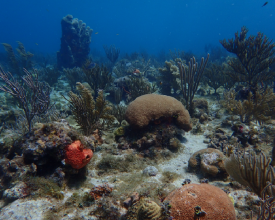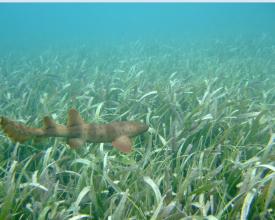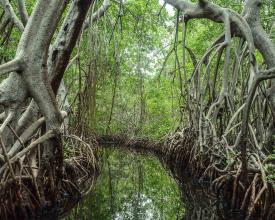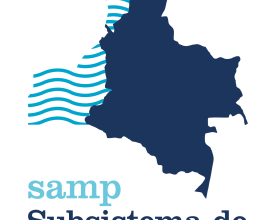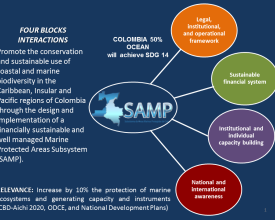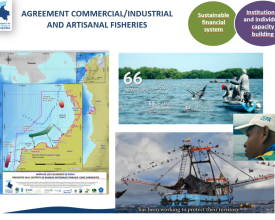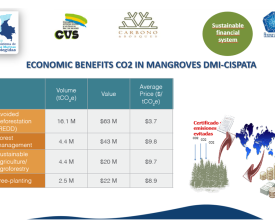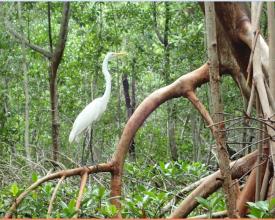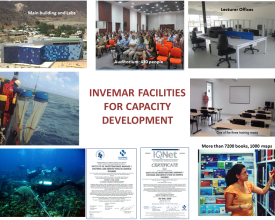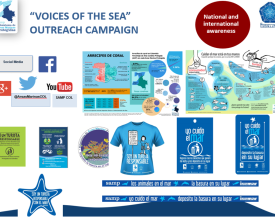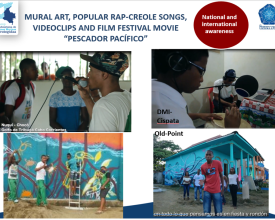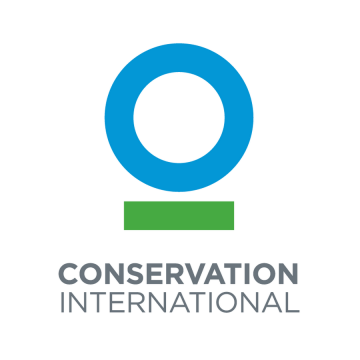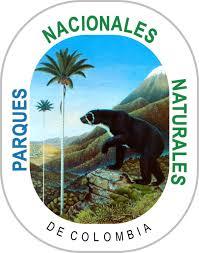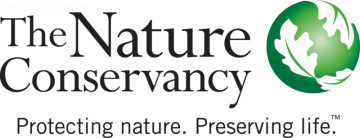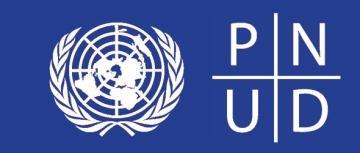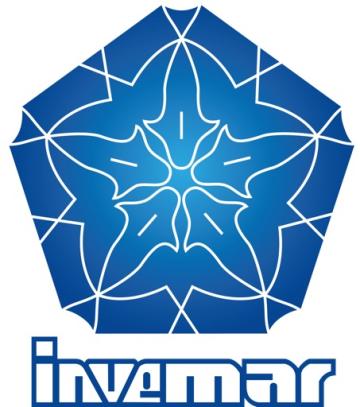
Colombia Subsystem of Marine Protected Areas (SMPA)
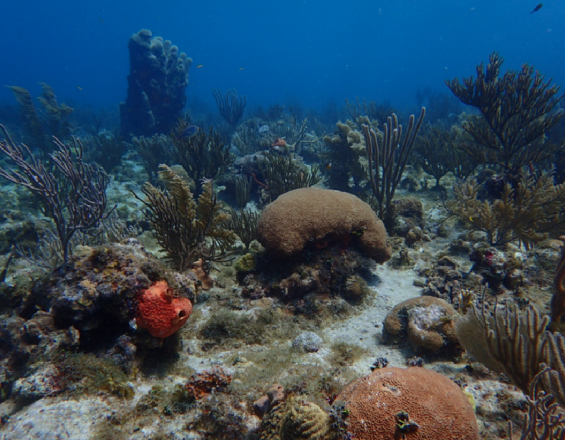
Ocean ecosystems are under-represented in the Colombian Protected Area System. SINAP, a group of public-private entities and local-communities, proposed to complement SINAP, stating: “It’s not only about the conservation but also about increasing public awareness of our oceans and to improve the institutional capabilities and well-being for local communities through mobilization and management of financial and non-financial resources for Marine Protected Areas." The solution led to the declaration of 11 new MPAs and the reduction of financial gaps for effective management; at 2015 investments to cover operational costs increased by 10%, and the annual government budget to 100%, the impacts were directly on implementation actions. Today, 13% of Colombia’s oceans are under protection accomplishing and exceeding Aichi Target 11 and SDG14. Enhanced capacities evaluated exceeded 70% expected results, and the methods developed have the potential to be replicated.
Context
Challenges addressed
- Upscale the representativeness of marine ecosystems within the Protected Area System of Colombia and to modify the perception of the importance of marine and coastal ecosystems as providers of environmental goods and services.
- Increase public and private investment for the protection of key marine and coastal ecosystems of the country.
- Establishing partnerships with public-private-comunity organizations to coordinate efforts for marine ecosystem conservation.
- Development of new methodologies for measurement of ecosystem based responses to climate change.
Location
Process
Summary of the process
The 4 blocks were the core of the Subsystem of Marine Protected Areas. The communication block was transversal and enabled production of the materials based on the information that come from the other 3 blocks.
The other 3 blocks worked in parallel: Advances and lesson learned were shared during the technical workshops and steering committe at least twice per year.
The institutional block was consider the base of interactions between horizontal and vertical governance squeme and support the financial block.
The capacity development block support the management of the MPA as well as increase the people, logistic resources and projection into the LatinAmerican and Caribbean Region the experiences including interactions between artisanal and industrial fishermen, local communities with environmental authorites, among others. The new people trained by this block were working into the other blocks. Communitation and Outreach put in place the results from 3 other blocks. The interaction between four blocks promote the adaptative management of the project as well as the management of MPAs and put in place the topics specially marine-ecosystem services and benefits and financial instruments into the national agenda.
Building Blocks
SAMP established and supported by a legal, institutional, and operational framework.
The SMPA is established and supported by a legal, institutional, and operational framework.
•Legal, institutional and operational framework:
8,6 million hectares under protection (8,9% aprox of marine areas)
11 new MPAs (initial target was 3)
2 Action Plans developed and supported: SIRAP Caribe y Pacífico: a) stakeholder analysis, articulation mechanisms, work plans, and specific actions for the MPAs to be included as part of action plans; b) reviewing the status of the processes for the SIRAPs’ establishment, at the same time taking into account the SINAP’s guidelines and facilitating the coordinated actions within the MPAs.
•Legal developments
SAMP Action Plan 2016 – 2023 design and start implementation
Formal adoption of SAMP by CONAP (National Protected Areas Council)
Operational agreements
Those results contributes to guarantee a representative sample of coastal and marine biodiversity at multiple biological organization levels; to assure the continuity of ecosystem services; to maintain the natural elements asociated to material and inmaterial importance objects essencial to cultural values; and to guarantee the ecological processes maintaining the conectivity of marine biodiversity.
Enabling factors
Political will and comunities openess to executing agency actions
Lesson learned
The complexity of marine ecosystems need imaginative approaches towards conservation in areas where comunities are almost entirely dependent on natural goods and services. Transactions between local stakeholders and public institutions through agreements aimed to assure sustainability of ecosystems while providing livelihoods for communities are necessary.
Marine Protected Areas Sub-system supported by a sustainable financial framework
The sustainable financial management plans are oriented to meet the needs of the Subsystem through the identification of activities run by the local communities which can raise revenues. Such activities include eco-tourism (scientific tourism, birdwatching, marine mammal watching), sport fishing, scenic diving and sustainable use of biodiversity resources. These plans are entailed towards the conservation of the ecosystem goods and services while giving economical opportunites to local communities and environmental entities. A financial framework ensuring the sustainability of the SAMP consolidated through the strengthening of current sources of financing and the inclusion of new ones. The framework includes the development of provisions and mechanisms to increase the current government and non-government contributions to the MPAs. Agreements to override MPA management cost with the direct beneficiaries of conservation was defined. To assess the potentiality of payments for avoided deforestation in mangroves as a financing option for MPAs and SAMP, a pilot project for the reduction of emissions caused by deforestation-degradation of mangroves was formulated and executed in Cispata. Now under replication and apply for "bluecarbon market".
Enabling factors
Identification of operational needs for the efficient and sustainable management of the marine protected areas.
Lesson learned
Private/Public/Local comunities and institutions are a key factor to ensure the proper means to raise budgetary needs.
Transparency in the management of the resources and open information strategies to follow the administration are important to gain confidence of the different actors in the process.
Enhanced institutional and individual capacity for SAMP management
The institutional and individual capacity for the management of the MPAs in the SAMP were improved: a) developed or strengthen training programs for MPA management (e.g., regulatory framework, management plans, financial
sustainability, and monitoring and conservation); b) developed of planning and resource use agreements; c) supported the consolidation of the MPA management plans; d) monitoring and use of GIS tools to aid MPA management decision-making was developed; and e) assessment of the MPA management effectiveness using the METT tool was runned. Additionally, the project contributed to enhance the institutional
capacity of INVEMAR and to improved MPA management by providing funds to update monitoring/research and GIS laboratories in new headquarters in Santa Marta. The main outputs: A monitoring system for the SMPA articulated with SINAP’; Agreements for planning and resource use developed for six (6) pilot MPAs specifying roles, financial obligations, and conflict-resolution mechanisms; Selected staff from MPAs and decision-makers trained in MPA management, financial planning, and monitoring and evaluation; Existing ecology programs in higher educational institutions include MPA; Decision Support System based-GIS tools.
Enabling factors
- Identification of needs for capacity building and development
- The expectations of decision makers, sectors and MPA managers as well as scientific and academic personnel
- The alliances between INVEMAR and their partners, as well as the possibility to link with Regional and Global Strategies (e.g. Ocean Teacher Global Academy - IOC-Unesco)
- The postgradute programmes are open to new subjects into the currilum (MPAs, Ocean Biodiversity)
Lesson learned
Good management needs good staff. Efforts conducted to enhance capabilities of officials towards gaining skills in managing marine environments are crucial for the success of the action.
Local comunities can be trained and can act as partners in the management of marine proteted areas.
Colombian and international communities are aware of SAMP - Communication and Outreach
Developed attitude and behavior assessment surveys targeting specific groups (e.g., visitors, local communities, and productive sectors) who visit or reside near MPAs carried out at different times. A web-based “Friends of the SMPA Society” comprised of national and international scientists and members of civil society were put in place. The project developed an information dissemination and communication strategy specific in marine topics, which will inform the general population about MPAs through print, audiovisual (radio, TV, newspapers, and internet), as well as dissemination meetings. The main activities were: a)Dissemination campaigns; b)implementation of the SAMP web page; c)awareness campaigns in educational centers (schools and universities); and d) establishment of a data base of images and videos bilingual (Spanish and English). SAMP promoted in international and national events of scientific nature, such as seminars, congresses, side-event in COP of Biodiversity, among others. Main results: 11% increase over the baseline of behavior and attitudes test scores; 5 new funding proposals leveraged by the “Friends of the SMPA Society"; national recognition at the end of the GEF-Project promoted a participatory roadmap for sustainability of next 5 years reacheness.
Enabling factors
Expectation about MPAs, as well as, the iconic topics on marine issues
Lesson learned
Different audiences require different approaches, different materials and different media for dissemination of their information or experiences.
Impacts
- 13% of Colombia’s oceans are under protection, accomplishing Aichi Target 11.
- More than 8.5 million ocean Ha are under protection (64.4% deep corals, 34% mangroves, 28% seagrasses, 96.5% corals, 22.6% beaches and 32% coastal cliffs), increasing the MPA network of Colombia by ~5 times the expected amount.
- More than 200 decision makers, MPA managers and sectorial actors have been trained on MPA-related topics.
- I8,570 Ha mangroves in Cispata-Caribbean have been protected, with the storage potential of ~521 tons of Carbon/Ha and in 3,700Ha have been protected in the Pacific, with ~220 tons of Carbon/ha.
- We developed a carbon storage methodology and in-situ equations for climate change mitigation with co-benefits for local communities.
- 4 business plans for MPAs have been developed (DRMI-Tribugá-Cabo Corrientes, DMI-Cispata, PNR-Old Point, DRMI-Caimanera).
- Regional Autonomus Corporations acquired skills to properly and effectively manage and preserve the MPAs.
- 66 agreements with fishermen that strengthen the planning of fishery resource uses between artisanal and indutrial fishermen.
- 3 financial sustainability agreements, with total investments to cover operational costs increased by 10% and the annual government budget to 100%.
Beneficiaries
- Local indigenous communties
- Coastal populations
- Marine protected areas administrators
- Scientists
Sustainable Development Goals
Story
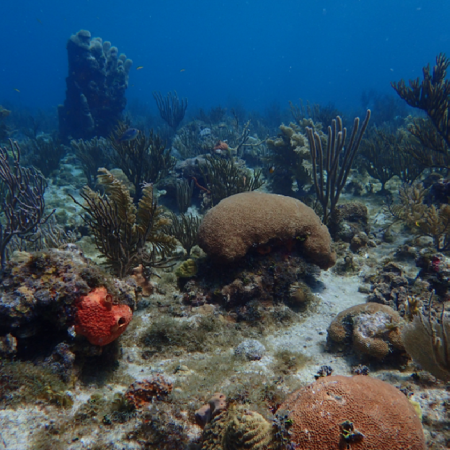
Working in Colombia, I have witnessed the great importance of coasts and seas for humanity, especially for people who live and work directly in these areas. In the INVEMAR, we are committed to the management of marine and coastal areas; we generate knowledge that will contribute to the improvement of the biodiversity, hence in the living conditions of people who depend on these areas. In Colombia, for over fifteen years, the issue of Marine Protected Areas (MPAs) has been considered a strategic position, and the advance in the design and implementation of the SMPA is the main instrument of conservation and protection of marine and coastal areas. Under this context, the project "Design and Implementation of the SMPA" has been advanced as key actions to meet the goal proposed in 2012 under the Convention on Biological Diversity (CBD): to have representative, effective and complete MPA systems at regional and national level, effectively managed and ecologically representative.
In terms of representativeness, Colombia´s MPAs represent about 9% near to the 10% proposed in the Aichi Biodiversity Target to the 2020. The project contributed to supporting the declaration process of four new MPAs such as the Deep Corals PNN that contains about 40% of biodiversity at the edge of the continental shelf of the Colombian Caribbean. The Portete PNN, the Gulf of Tribuga DRMI and the Acandi SF, in which its declaratoration had an important participation and work with local stakeholders, which include local communities, mainly Wayuu Indigenous and Afro-Colombian communities. Through the project, we also strengthened management with users of MPAs, which is reflected in alternative livelihoods for coastal communities that depend on these areas for their food security. An example of this is the achievements in areas such as Cispata DMI, which have a validation process as a REDD+ type project in mangroves. The National Protected Areas Council (CONAP - Spanish acronym) of Colombia considers that the strategy for the harmonization and management in MPAs is the creation and operation of the SAMP.

